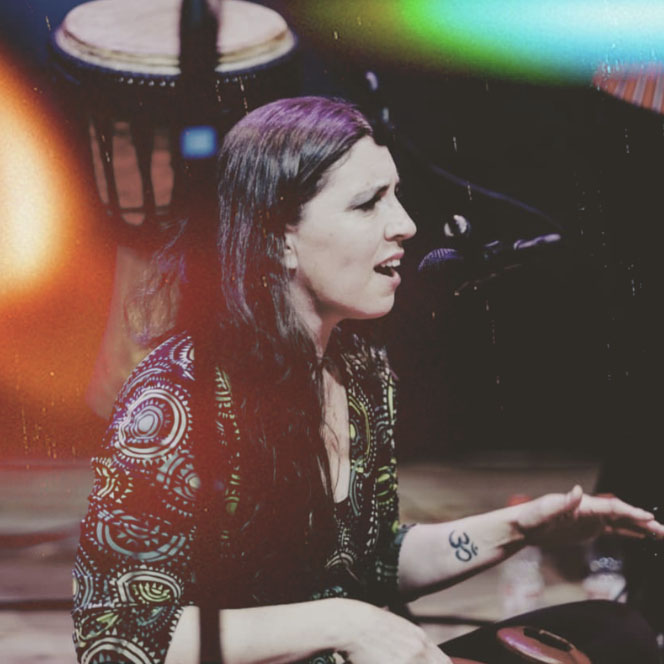Ark - 2022
- HD, color, sound, 30 min.
- Transmedia / Expanded Cinema
- Collaboration with Claudia Espinoza Castillo (Flamenco), Antonia Schmidt (music) and Sonia Leliukh (illustration)
- Germany

EN
"Ark" is the musical interlude of a three-act short film that tells stories of immigration and cultural clashes in the NRW.
The first act ends with the first bombings of the Second World War, which become the stomping of a flamenco dancer. This dance style represents the epitome of the nomadic spirit, as it is a combination of movements that embodies an amalgamation of cultures and its origins are, to this day, unclear. On one hand, flamenco is one of the most distinctive dances of the Romani, a population of groups with no official homeland closely associated with Spain, but who were named in history texts as early as 1340 in Cologne before their large settlements in Andalusia, Murcia or Extremadura. On the other, although it is widely claimed that flamenco was created from the diverse languages and cultures of the Gypsies and their encounters with the Moors and their exposure to sefardi music, relevant studies suggest that it existed in the region of Andalusia before the arrival of the Gypsies in the area and could therefore be the result of centuries of pilgrimage and juxtaposition of cultures. Even so, it could be said that Flamenco carries, in its simple staging of dance, an immigrant sense, an easy-going, portable purpose; an essence of an undefined home.
This prototype project will be used to finance the entire play, through the public projection of the choreography in a fragmented way.
DE
"Ark" ist das musikalische Zwischenspiel eines dreiaktigen Kurzfilms, der Geschichten von Zuwanderung und Kulturdilemmas in NRW erzählt.
Der erste Akt endet mit den ersten Bombenangriffen des Zweiten Weltkriegs, die sich in das Stampfen einer Flamenco-Tänzerin verwandeln. Dieser Tanzstil ist der Inbegriff des Nomadengeistes, denn er ist eine Kombination von Bewegungen, die eine Verschmelzung der Kulturen verkörpert, und sein Ursprung ist bis heute unklar. Einerseits ist der Flamenco einer der charakteristischsten Tänze der Romani, einer Bevölkerungsgruppe ohne offizielle Heimat, die eng mit Spanien verbunden ist, aber bereits 1340 in Köln in Geschichtsbüchern erwähnt wurde, bevor sie sich in Andalusien, Murcia oder der Extremadura niederließ. Andererseits wird zwar weithin behauptet, dass der Flamenco aus den verschiedenen Sprachen und Kulturen der Romani, ihren Begegnungen mit den Mauren und ihrem Kontakt mit der sefardi Musik entstanden ist, doch legen einschlägige Studien nahe, dass er bereits vor der Ankunft der Zigeuner in Andalusien existierte und somit das Ergebnis einer jahrhundertelangen Pilgerreise oder eines Nebeneinanders von Kulturen sein könnte. Dennoch könnte man sagen, dass der Flamenco in seiner einfachen tänzerischen Inszenierung ein Gefühl der Zuwanderung, der Unbeschwertheit und der Tragbarkeit vermittelt, eine Essenz einer unbestimmten Heimat.
Dieses prototypische Projekt wird dank der fragmentierte Projektion der Choreografie zur Finanzierung des Gesamtwerks dienen.
ES
“Ark” es el intermedio musical de un cortometraje de tres actos que narra historias de inmigración y choques culturales en la NRW.
El primer acto termina con los primeros bombazos de la segunda guerra mundial, los cuales se convierten en el zapateo de una bailaora de flamenco. Este estilo de baile representa el epítome del espíritu nómada, ya que es una conjunción de movimientos que personifica una amalgama de culturas y su origen es, hasta hoy, impreciso. Por un lado, el flamenco es una de las danzas más distintivas de los gitanos o Romani, una población de grupos sin patria oficial muy asociada a España, pero que fueron nombradas en textos de historia ya en 1340 en Colonia antes de sus grandes asentamientos en Andalucía, Murcia o Extremadura. Por otra parte, aunque mayoritariamente se afirma que el flamenco se creó a partir de las diversas lenguas y culturas de los gitanos y sus encuentros con los moros y su exposición a la música sefardí, estudios relevantes apuntan a que existió en la región de Andalucía antes de la llegada de los gitanos a la zona y, por lo tanto, podría ser fruto de siglos de peregrinaje y de yuxtaposición de culturas. Aun así, podría decirse que el Flamenco lleva, en su sencilla puesta en escena de baile, un sentido inmigrante, un propósito fácil de llevar, portátil; una esencia de un hogar indefinido.
Este proyecto prototipo se utilizará para financiar la obra completa, gracias a la proyección de la coreografía una manera fragmentada.




